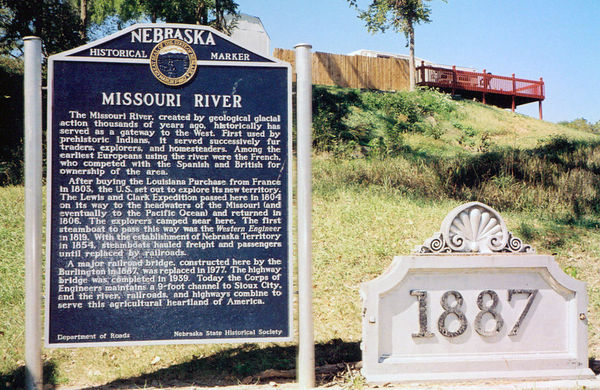Nebraska Historical Marker: Missouri River
Location
Bayliss St, Rulo, Richardson County, Nebraska
View this marker's location 40.052407, -95.42530
View a map of all Nebraska historical markers, Browse Historical Marker Map
Marker Text
The Missouri River, created by geological glacial action thousands of years ago, historically has served as a gateway to the west. First used by prehistoric Indians, it served successively fur trader, explorers, and homesteaders. Among the earliest Europeans using the river were the French, who competed with the Spanish and British for ownership of the area. After buying the Louisiana Purchase from France in 1803, the U.S. set out to explore its new territory. The Lewis and Clark Expedition passed here in 1804 on its way to the headwaters of the Missouri (and eventually to the Pacific Ocean) and returned in 1806. The explorers camped near here. The first steamboat to pass this way was the Western Engineer in 1819. With the establishment of Nebraska Territory in 1854, steamboats hauled freight and passengers until replaced by railroads. A major railroad bridge, constructed here by the Burlington in 1887, was replaced in 1977. The highway bridge was completed in 1939. Today the Corps of Engineers maintains a 9-foot channel to Sioux City, and the river, railroads, and highways combine to serve this agricultural heartland of America.
Further Information
Bibliography
Charles E Hanson Jr and Veronica Sue Walters, “The Early Fur Trade in Northwestern Nebraska,” Nebraska History 57 (1976): 291-314
Daniel Henry Ehrlich, “Problems Arising from Shifts of the Missouri River on the Eastern Border of Nebraska,” Nebraska History 54 (1973): 340-363
Capt H M Chittenden, “Report on Steamboat Wrecks on Missouri River,” Nebraska History 51 (1970): 16-23
Norman A Graebner, “Nebraska’s Missouri River Frontier, 1854-1860,” Nebraska History 42 (1961): 213-235
Marker program
See Nebraska Historical Marker Program for more information.
